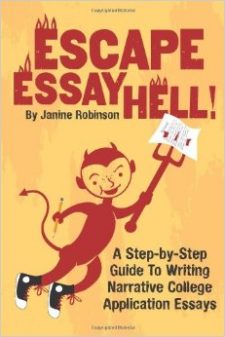
Go Deep
in Your College Application Essay!
When writing narrative-style college application essays, I advise students to start by sharing a real-life story that illustrates one of their defining qualities or characteristics.
All stories contain some type of problem. It’s just the universal nature of all stories—there’s a conflict of some type. I call these problems.
Once a student shares a real-life story with a problem (either big or small), they are poised to explain how they dealt with it.
Then comes the most important part: What they learned in the process.
This analysis, reflection or questioning is the most important part of an effective college application essay. Why? Because this is where a student can show colleges how they think, what they care about and what they value.
It’s called “intellectual vitality.”
I wrote an essay writing guide last year, the Writing Survival Kit, where I shared 50 tips, techniques and strategies for writing these essays.
I want to share with my tips on how to bring this type of depth into your essay. Here’s an excerpt from my guide that features one hot strategy on how to bring this depth into your essay (Here’s my second post on how to show intellectual vitality.):
Chapter Six
DIG DEEP
In your narrative essay, you share something that happened, usually with an anecdote.
Now you need to help the reader understand why it mattered to you.
These writing tools will help you explore and explain in your essay the meaning of what happened.
This will give your essay depth and show the reader how you think, and your ability to analyze and reflect.
1. Explain Meaning by “Telling”
Even though most narrative essays start with some type of real-life moment or incident (anecdote), they are more than recounting an entertaining story. The point is to share a story in order to examine what it meant to you, and what you learned from it.
The anecdote or mini-story will usually only take up the first part of your essay; the rest is all what you have to say about what it meant, its significance. This is when you get to reveal how you think, what you care about and how you learn.
After you engage your reader with an anecdote—which illustrates the point you want to make about yourself in the essay—it’s time to go on and explain what it all means and why it matters to you and others.
One way to bring depth to your analysis is to reflect on what happened. Here are some lines that might help you share your thoughts and ideas:
“When I look back, I now realize….”
“Years later, I now believe…”
“It took me a while, but I now suspect that…”
“When I explored the events that led up to that day, I often think…”
“On another level, I now view it…”
“It caught me by surprise, but I now understand that…”
“After while, I started to think about all that I learned…”
“In some ways, I changed…”
You shared something that happened. That was “showing.” After that, your essay is all about explaining—“telling”—what it meant.
* * * * *
If you like this approach and want to learn how to apply it in a step-by-step manner, you might want to consider my writing guide, Escape Essay Hell! or my online writing course on How to Write a Killer College Application Essay.
Or just keep reading this blog!







